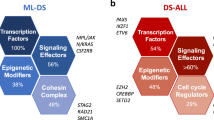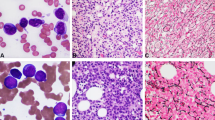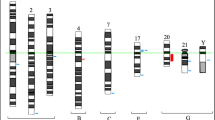Abstract
Based on our previous results indicating the presence of a tumor suppressor gene (TSG), chromosome 21 was analysed for loss of heterozygosity (LOH) in 18 patients with acute myeloid leukemia (17, AML-M0; one, AML-M1). Allelotyping at polymorphic loci was performed on purified material, allowing unequivocal detection of allelic loss and homozygous deletions. Six AML-M0 patients shared a common region of LOH harboring a single gene: RUNX1 (AML1), the most frequent site of translocations in acute leukemia and a well-known fusion oncogene. Fluorescence in situ hybridization allowed the identification of deletions with breakpoints within RUNX1 in two patients as the cause of LOH. In the four others the LOH pattern and the presence of two karyotypically normal chromosomes 21 were in line with mitotic recombination. Further molecular and cytogenetic analyses showed that this caused homozygosity of primary RUNX1 mutations: two point mutations, a partial deletion and, most significantly, a complete deletion of RUNX1. These findings identify RUNX1 as a classical TSG: both alleles are mutated or absent in cancer cells from four of the 17 AML-M0 patients examined. In contrast to AML-M0, the AML-M1 patient was trisomic for chromosome 21 and has two mutated and one normal RUNX1 allele, suggesting that the order of mutagenic events leading to leukemia may influence the predominant tumor type.
This is a preview of subscription content, access via your institution
Access options
Subscribe to this journal
Receive 50 print issues and online access
$259.00 per year
only $5.18 per issue
Buy this article
- Purchase on Springer Link
- Instant access to full article PDF
Prices may be subject to local taxes which are calculated during checkout




Similar content being viewed by others
References
Bennett JM, Catovsky D, Daniel MT, Flandrin G, Galton DA, Gralnick HR and Sultan C . (1985). Ann. Intern. Med., 103, 620–625.
Bennett JM, Catovsky D, Daniel MT, Flandrin G, Galton DA, Gralnick HR and Sultan C . (1991). Br. J. Haematol., 78, 325–329.
Buijs A, Poddighe P, van Wijk R, van Solinge W, Borst E, Verdonck L, Hagenbeek A, Pearson P and Lokhorst H . (2001). Blood, 98, 2856–2858.
Cockerill PN, Osborne CS, Bert AG and Grotto RJ . (1996). Cell Growth Differ., 7, 917–922.
de Nooij-Van Dalen AG, Morolli B, van der Keur M, van der Marel A, Lohman PH and Giphart-Gassler M . (2001). Genes Chromosomes. Cancer, 30, 323–335.
de Nooij-Van Dalen AG, van Buuren-van Seggelen VH, Lohman PH and Giphart-Gassler M . (1998). Genes Chromosomes Cancer, 21, 30–38.
Devilee P, Cleton-Jansen AM and Cornelisse CJ . (2001). Trends Genet., 17, 569–573.
Friedman AD, Britos-Bray M and Suzow J . (1996). Leukot. Res., 20, 809–815.
Giese K, Kingsley C, Kirshner JR and Grosschedl R . (1995). Genes Dev., 9, 995–1008.
Giphart-Gassler M, Nooij-Van Dalen A, Buuren-Van Seggelen V, Morolli B, Lohman P and Kluin-Nelemans H . (1998). Mutat. Res., 400, 409–419.
Hiebert SW, Lutterbach B and Amann J . (2001). Curr. Opin. Hematol., 8, 197–200.
Holt D, Dreimanis M, Pfeiffer M, Firgaira F, Morley A and Turner D . (1999). Am. J. Hum. Genet., 65, 1423–1427.
Kagoshima H, Akamatsu Y, Ito Y and Shigesada K . (1996). J. Biol. Chem., 271, 33074–33082.
Kitabayashi I, Yokoyama A, Shimizu K and Ohki M . (1998). EMBO J., 17, 2994–3004.
Knudson AG . (1993). Proc. Natl. Acad. Sci. USA, 90, 10914–10921.
Krug U, Ganser A and Koeffler HP . (2002). Oncogene, 21, 3475–3495.
Langabeer SE, Gale RE, Rollinson SJ, Morgan GJ and Linch DC . (2002). Genes Chromosomes Cancer, 34, 24–32.
Lenny N, Westendorf JJ and Hiebert SW . (1997). Mol. Biol. Rep., 24, 157–168.
Lichter P, Ledbetter SA, Ledbetter DH and Ward DC . (1990). Proc. Natl. Acad. Sci. USA, 87, 6634–6638.
Look AT . (1997). Science, 278, 1059–1064.
Lund AH and van Lohuizen M . (2002). Cancer Cell, 1, 213–215.
Mao S, Frank RC, Zhang J, Miyazaki Y and Nimer SD . (1999). Mol. Cell Biol., 19, 3635–3644.
Meyers S, Downing JR and Hiebert SW . (1993). Mol. Cell Biol., 13, 6336–6345.
Meyers S and Hiebert SW . (1995). Crit Rev. Eukaryot. Gene Expr., 5, 365–383.
Michaud J, Wu F, Osato M, Cottles GM, Yanagida M, Asou N, Shigesada K, Ito Y, Benson KF, Raskind WH, Rossier C, Antonarakis SE, Israels S, McNicol A, Weiss H, Horwitz M and Scott HS . (2002). Blood, 99, 1364–1372.
Mikhail FM, Serry KA, Hatem N, Mourad ZI, Farawela HM, El Kaffash DM, Coignet L and Nucifora G . (2002). Leukemia, 16, 658–668.
Mitelman F . (ed). (1995). ISCN (1995). An International System for Human Cytogenetic Nomenclature. S. Karger: Basel.
Miyoshi H, Ohira M, Shimizu K, Mitani K, Hirai H, Imai T, Yokoyama K, Soeda E and Ohki M . (1995). Nucleic Acids Res., 23, 2762–2769.
Nagata T and Werner MH . (2001). J. Mol. Biol., 308, 191–203.
Ogawa E, Inuzuka M, Maruyama M, Satake M, Naito-Fujimoto M, Ito Y and Shigesada K . (1993). Virology, 194, 314–331.
Osato M, Asou N, Abdalla E, Hoshino K, Yamasaki H, Okubo T, Suzushima H, Takatsuki K, Kanno T, Shigesada K and Ito Y . (1999). Blood, 93, 1817–1824.
Petrovick MS, Hiebert SW, Friedman AD, Hetherington CJ, Tenen DG and Zhang DE . (1998). Mol. Cell Biol., 18, 3915–3925.
Preudhomme C, Warot-Loze D, Roumier C, Grardel-Duflos N, Garand R, Lai JL, Dastugue N, Macintyre E, Denis C, Bauters F, Kerckaert JP, Cosson A and Fenaux P . (2000). Blood, 96, 2862–2869.
Redondo JM, Pfohl JL, Hernandez-Munain C, Wang S, Speck NA and Krangel MS . (1992). Mol. Cell Biol., 12, 4817–4823.
Song WJ, Sullivan MG, Legare RD, Hutchings S, Tan X, Kufrin D, Ratajczak J, Resende IC, Haworth C, Hock R, Loh M, Felix C, Roy DC, Busque L, Kurnit D, Willman C, Gewirtz AM, Speck NA, Bushweller JH, Li FP, Gardiner K, Poncz M, Maris JM and Gilliland DG . (1999). Nat. Genet., 23, 166–175.
Speck NA and Gilliland DG . (2002). Nat. Rev. Cancer, 2, 502–513.
Sudol M . (1994). Oncogene, 9, 2145–2152.
Tahirov TH, Inoue-Bungo T, Morii H, Fujikawa A, Sasaki M, Kimura K, Shiina M, Sato K, Kumasaka T, Yamamoto M, Ishii S and Ogata K . (2001). Cell, 104, 755–767.
Tanaka T, Tanaka K, Ogawa S, Kurokawa M, Mitani K, Yazaki Y, Shibata Y and Hirai H . (1997). Leukemia, 11(Suppl 3), 299–302.
Tanke HJ, Wiegant J, van Gijlswijk RP, Bezrookove V, Pattenier H, Heetebrij RJ, Talman EG, Raap AK and Vrolijk J . (1999). Eur. J. Hum. Genet., 7, 2–11.
Uchida H, Zhang J and Nimer SD . (1997). J. Immunol., 158, 2251–2258.
van Dam FJ, Natarajan AT and Tates AD . (1992). Mutat. Res., 271, 231–242.
Vrieling H . (2001). Nat. Genet., 28, 101–102.
Wang Q, Stacy T, Binder M, Marin-Padilla M, Sharpe AH and Speck NA . (1996). Proc. Natl. Acad. Sci. USA, 93, 3444–3449.
Wang S, Wang Q, Crute BE, Melnikova IN, Keller SR and Speck NA . (1993). Mol. Cell Biol., 13, 3324–3339.
Wang SW and Speck NA . (1992). Mol. Cell Biol., 12, 89–102.
Westendorf JJ, Yamamoto CM, Lenny N, Downing JR, Selsted ME and Hiebert SW . (1998). Mol. Cell Biol., 18, 322–333.
Zhang DE, Hetherington CJ, Meyers S, Rhoades KL, Larson CJ, Chen HM, Hiebert SW and Tenen DG . (1996). Mol. Cell Biol., 16, 1231–1240.
Acknowledgements
We thank H Vrieling, P Devilee and LG Fradkin for discussions and critical review of this manuscript; RAThW Gouw and KHG Kroeze-Jansema (Department of Human Genetics) for technical assistance, R van der Linden and M van der Keur (Department of Hematology) for cell sorting and G de Groot-Swings (Department of Hematology) for her help with the collection of cells. This work was supported by the Inter University Institute for Radio Pathology and Radiation Protection (IRS), and by the grants from the Calouste Gulbenkian Foundation and the Foundation for Science and Technology (Portugal) to FPG Silva.
Author information
Authors and Affiliations
Corresponding author
Rights and permissions
About this article
Cite this article
Silva, F., Morolli, B., Storlazzi, C. et al. Identification of RUNX1/AML1 as a classical tumor suppressor gene. Oncogene 22, 538–547 (2003). https://doi.org/10.1038/sj.onc.1206141
Received:
Revised:
Accepted:
Published:
Issue Date:
DOI: https://doi.org/10.1038/sj.onc.1206141
Keywords
This article is cited by
-
Uncovering missed indels by leveraging unmapped reads
Scientific Reports (2019)
-
The RUNX1–PU.1 axis in the control of hematopoiesis
International Journal of Hematology (2015)
-
TdT expression in acute myeloid leukemia with minimal differentiation is associated with distinctive clinicopathological features and better overall survival following stem cell transplantation
Modern Pathology (2013)
-
The RUNX family in breast cancer: relationships with estrogen signaling
Oncogene (2013)
-
Exposure to ionizing radiation induced persistent gene expression changes in mouse mammary gland
Radiation Oncology (2012)



